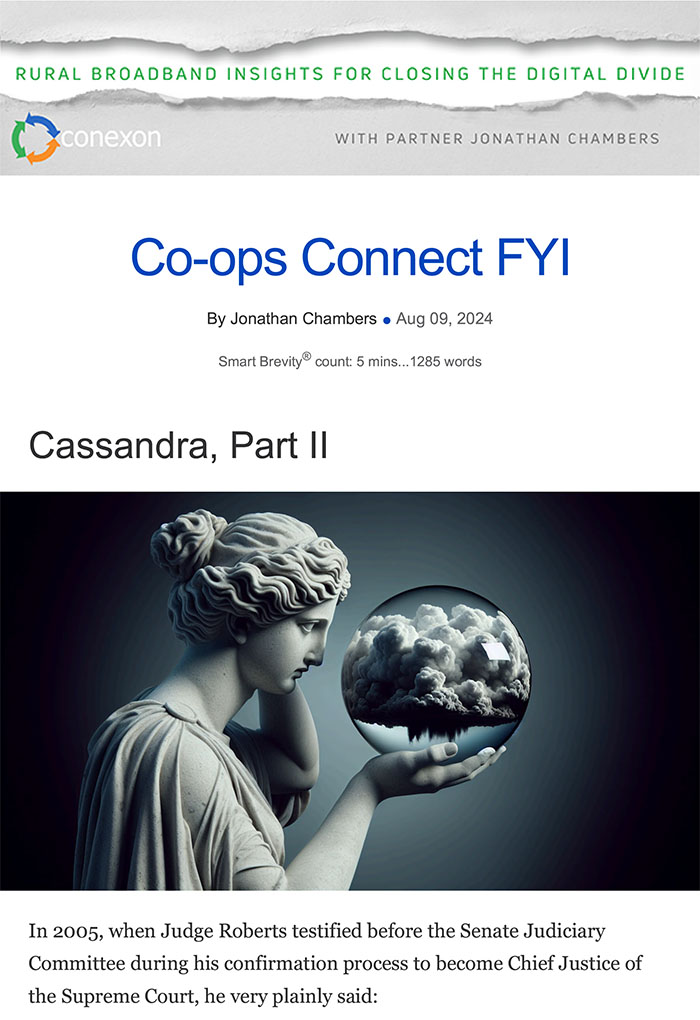Cassandra, Part II
August 9, 2024

In 2005, when Judge Roberts testified before the Senate Judiciary Committee during his confirmation process to become Chief Justice of the Supreme Court, he very plainly said:
Judges are like umpires. Umpires don’t make the rules, they apply them. The role of an umpire and a judge is critical. They make sure everybody plays by the rules, but it is a limited role. Nobody ever went to a ball game to see the umpire.
Judges have to have the humility to recognize that they operate within a system of precedent shaped by other judges equally striving to live up to the judicial oath, and judges have to have the modesty to be open in the decisional process to the considered views of their colleagues on the bench.
I don’t know if Judge Roberts ever played baseball; apparently, he is a fan of the game. I assume he knows that one of the most critical attributes of an effective umpire is consistency.
- If an umpire expands or shrinks the strike zone during the game, the batter cannot know whether to take a ball or swing at a pitch.
- The pitcher cannot know where to throw the ball.
- The catcher cannot know how to signal the pitch. If the umpire changes the strike zone from pitch to pitch, it is no longer baseball. It is chaos.
That is the current state of the Supreme Court. Chaos.
Consistency (or in court-talk, “precedent”) is of no import to the current Court, which has been flirting with chaos these past few years.
- A month ago, in the Loper decision, the Court overturned the unanimous 40-year-old Chevron decision. Chevron was a landmark decision that established that federal courts must defer to a federal agency when interpreting a statute that agency administers, as long as the statute is ambiguous, and the agency’s interpretation is reasonable.
The Impact on Rural Broadband

What’s all this got to do with rural broadband?
Last month, the Fifth Circuit Court issued a decision that effectively invalidated the FCC’s Universal Service programs. These programs include everything from support for rural broadband to support for schools and libraries to support for low-income households.
- In essence, the Fifth Circuit Court ruled that the FCC’s mechanisms for collecting funds from telecommunications carriers is now an impermissible tax.
- Two other circuit courts have upheld the FCC’s universal service programs following similar challenges.
- The FCC is appealing the Fifth Circuit Court’s ruling to the Supreme Court. Since there is a split among the circuit courts, the Supreme Court is likely to hear the cases during its next term.
By way of background, the current FCC universal service programs were largely an outgrowth of the 1996 Telecommunications Act. For decades, telecommunications carriers were regulated monopolies.
- Through a series of byzantine regulatory schemes, state and federal regulators attempted to achieve equitable economic outcomes by requiring that certain telecommunications services subsidize other services.
- Long-distance services subsidized local calling. Business service subsidized residential. Large companies subsidized small companies.
- In this way, services were affordable to more people and more businesses, and the pricing power of these regulated monopolies was limited.
The 1996 Act put an end to the de jure and de facto telecommunications monopolies.
- As part of that new legislative direction, the existing internal subsidy mechanisms were made explicit and then competitive.
- The process took 25 years, and the FCC still has not fully completed the transition.
- Prior to the Loper decision, the FCC’s two decades-long work would not face serious legal challenge.
Now, it's a new ballgame.
What's At Stake

What’s at stake (or newly vulnerable):
- In 1997, the FCC disbursed $1.7 billion in universal service funding. In 2023, the FCC disbursed $8.5 billion, an increase that is more than double the rate of inflation. If the Supreme Court agrees with the Fifth Circuit, all that funding is at risk.
- The FCC has regulatory authority over interstate and international telecommunications, so the FCC “assesses” (not taxes) revenue from those services. Since the assessment base has been shrinking as such services have been disappearing, the assessment rate (not a tax rate) has skyrocketed.
In 1997, the “contribution factor” – the percent of interstate and international telecommunications revenues assessed by the FCC – was 3.2%. Today, the contribution factor is 34.4%, more than a ten-fold increase. If the Supreme Court finds the FCC’s contribution mechanism not clearly correct, the FCC may need to look for other revenue to assess. - If the Supreme Court finds the FCC’s current funding mechanism flawed, the FCC may attempt to assess broadband revenues as well.
But the FCC’s re-classification of broadband as a telecommunications service is being challenged in a different case making its way to the Supreme Court - The universal service provisions in the Communications Act require a discount for services provided to schools and libraries by telecommunications carriers. The schools and libraries program (nicknamed the e-rate program) could have been a simple requirement that companies offer schools their lowest available rate. Instead of regulating the rates charged to schools and libraries, the FCC chose to create e-rate as a government spending program.
Since the implementation of the schools and libraries program, the FCC has spent $55 billion, including funds to wire classrooms for Wi-Fi and build fiber networks.
Annually, the FCC now spends upwards of $4.8 billion on e-rate. The Supreme Court could disagree with the FCC’s interpretation of its authority to create a spending program for schools and libraries. The e-rate program is also at risk. - With the passage of BEAD, Congress appropriated $42.5 billion for the construction of broadband networks to unserved and underserved (largely rural) areas.
After Congress enacted BEAD, the FCC established a new $15 billion subsidy program for small telephone companies in the same areas Congress identified for BEAD. The Court may use this new program to illustrate the unfettered authority that the FCC arrogates to itself, while pointing to the BEAD program as evidence that Congress is perfectly capable of appropriating funds for rural broadband.
Non-BEAD rural funding is now at risk.
My Forecast

There are analysts who will tell you that the Supreme Court will not strike down the FCC’s authority; that it would be too disruptive to decades of established telecommunications practice.
Well. I’ve just downloaded Justice Neil Gorsuch’s new book, Over Ruled: The Human Toll of Too Much Law.
- Gorsuch argues Chevron had placed a systemic weight on the scale of justice in favor of government instead of individuals.
- Post-Chevron, the FCC will not be able to argue that its interpretation of the Communications Act is merely reasonable. It now will have to convince the Court that its interpretation is correct.
- Loper shifts the power to the courts to decide, and not the agency administering the regulation.
I believe the Supreme Court will strike down the FCC’s authority to continue to collect funds using its current mechanism, which in turn will require Congress to fill the FCC’s Universal Service coffers.
I also believe the FCC and the Department of Commerce should start now preparing for the FCC’s funding mechanism to be struck down.
- They should permit BEAD funds to be spent in CAF, ACAM, and RDOF areas.
- At a minimum, the FCC should pause build-out milestones until the Supreme Court rules on the FCC’s appeal of the Fifth Circuit’s decision; at least then companies aren’t forced to spend any more money until they know the FCC can fulfill its end of the bargain.
Some months back, I wrote about Cassandra (read May 31 Co-ops Connect FYI).
This time, I’m again hoping to be wrong.
